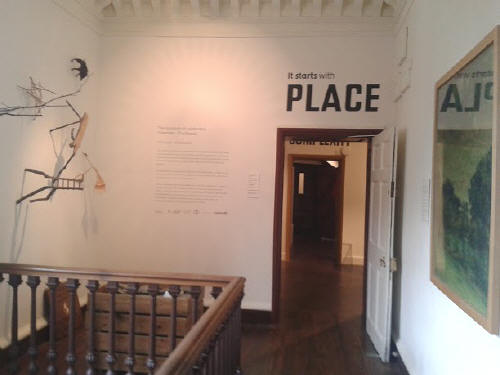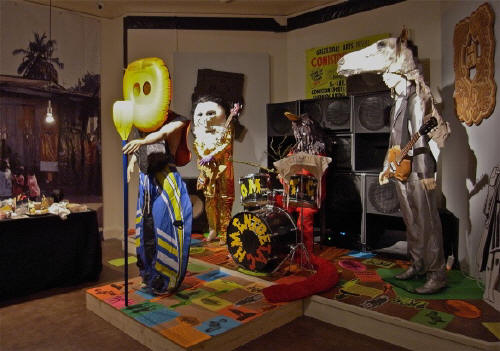|
|
| home | features | exhibitions | interviews | profiles | webprojects | gazetteer | archive |
|
Field Notes on ritual, Cumbria and cultural communities Field Notes is a projects organisation run by curatorial team Rosie Thomson-Glover and Cat Bagg. e-interview by Rupert White
Can you explain how Field Notes came about? We met and began working together whilst studying on MA Curatorial Practice at Falmouth University. We spent a lot of time working together and discovered that we make a good team! The course was incredibly intensive and required a combination of clarity of thought, theoretical understanding and practical nous that meant our practices were hugely strengthened when we combined our skill sets. Weíre both passionate about understanding the context of a project - why it should happen, now, in this place and what local and cultural history makes it a good idea, or challenges it. As well as seeking to really understanding who its for; creating opportunity for audiences to access current, high quality art from around the world is another starting point for our projects. During our time on the MA we found that we had a shared a level of ambition in terms of scope, reach and quality and always intended to work together on a project or two after the course. But when we began to talk about the purpose of these projects and what they could achieve, we both felt that there was a need for and space to start an independent projects company in Cornwall. We wanted to create a model that could develop responsively and would allow us to begin to build on the legacy of events we produced whilst maintaining an awareness of our social responsibility as a business. From that point on it was clear that anything we initiated would be much more than a few disparate projects and that to take it forward we needed to find a way to package or house our practice; ensuring it could reach its full potential, we started Field Notes in April 2014.
Rituals Are Tellers of Us (right) was actually curated for Newlyn in 2013 as part of our MA and was a real eye opener, particularly with regards to dealing with systems some of larger institutions and established artists use. The exhibition was developed with our fellow students Rosie Leo, who has been working at ACT, and Keziah Hughes, who is working in Kent. The show was a contemporary art celebration of folk traditions and explored the necessity of ritual as a way of creating community; through storytelling, communal actions, the airing of fears and establishing of myths that help to preserve rural culture. It seemed like an appropriate way to link elements of the fabric of Cornwall with ideas being developed by local, national and international artists - an interesting way to see the parallels and distances created by people; simultaneously shrinking the space between communities and breaking open the ways in which we find to communicate and share ideas. Those core ideas have very much stayed with Field Notes - ideas around collaboration and community remain as undercurrents to many of the projects we develop.
The recent Inland Art Festival was probably your most ambitious project. Can you describe it? Inland has definitely been our biggest project to date, in so many ways. Based across the centre of Redruth, we were really aware of who the festival was for and spent a lot of time puzzling out the best way to feed the needs of some really diverse social and cultural communities. As a town it is easy and unusually quick to access from most of Cornwall, it has a strong and innovative community of practicing artists and a host of established arts organisations, such as Back Lane West, CMR and Krowji. Interestingly though there is no historical legacy of art activity, making it something of a rarity and an unusual place to host a contemporary art event in Cornwall, compared with towns such as St Ives, Penzance or Falmouth which have long established associations with the arts. We felt that the festival had to serve the art community in Redruth and the surrounding areas by celebrating the existing local activity and bringing it into dialogue with contemporary practice from further afield. It was also important to us that the festival would reach a local non arts audience without compromising on the quality and stature of the work on show.
The festival had an incredibly positive response, both in terms of audience numbers and feedback. A highlight was definitely the discussion led by Blair Todd (Exhibitions Curator at Newlyn Art Gallery & The Exchange). To have representatives of so many of the innovative and tireless artist led groups and individual practitioners both from Cornwall and further afield all discussing, critiquing and celebrating each others experiences was incredibly exciting. The key for us going forward will be in maintaining the channels of dialogue that were begun and ensuring that they remain open to new voices.
Presumably as curators, quite a lot of your time is spent doing research. You went to the Venice Biennale in 2012, and visited Adam Sutherland in Grizedale more recently. What did you see up at Grizedale? One thing we firmly believe at Field Notes is that the work we celebrate and support has to be able to relate to, challenge or engage with a wider cultural conversation as well as sit within the community where it sites itself. The practices that we encounter in Cornwall bear just as much weight and relevance as work made in the metropolises that are commonly seen to make up the art world. One way we make sure that we stay switched on and aware of whatís happening is to visit, talk about and talk to the people and places that are advocates for this kind of independent practice. In 2013 we visited Venice and spent a week scouring The Biennale for ways that a native community, an art aware transient audience and an ever present tourism sector can have their perceptions challenged, their awareness heightened and their experience enhanced by contemporary art on a hyper-scale! It was a brilliant experience - the sheer mass and generosity of ideas and knowledge was a joyous whirlwind to be swept up in. At the end of last year, we visited Grizedale Arts up in the Lake District; it was a very different experience but it held its own mantle of generosity, relevance and humour. The focus of our visit was to see The Nuisance of Landscape - a retrospective showcasing Grizedaleís output since 1999 (below x2). This charted their move out of the forest and into a village, as well as notable forays into arts organisations and communities around the world. The exhibition was held across multiple venues; an arts and craft house, a stunning regional museum and The Coniston Instituteís village hall. It was an aesthetically exquisite and fascinating journey into artsí ability to be useful whilst remaining challenging and culturally interesting in the broadest possible sense. It was also a great example of how conventional and alternative institutions in an area can work together to reach a wider audience. We also got the opportunity to have a cup of tea and a jaffa cake with Adam Sutherland and take a look around Lawson Park, their stunning residency centre.
The similarities between Cornwall and Cumbria played a big part in our decision to travel to Grizedale. Before we went they seemed obvious; two areas of England renowned for their beautiful scenery, where tourism is the primary industry and which are similarly remote from the cultural centres of London and other large cities. However the more we explored, the more differences we found. The Lake District is much more rural and significantly, the cultural history is predominantly literary rather than art based. Perhaps as a consequence, they donít have anything like the large scale community of artists who are living and working here, in Cornwall. We see Grizedale as one of the front runners of an exciting, contemporary rural arts model that serves a highly specific context so there are certainly interesting parallels to be drawn between Grizedale and Field Notesí ambitions. Particularly in the way that they have built a deep rooted position for themselves in their local community, whilst still engaging with the wider art world. Although the visit didnít change our perception of Cornwall, it highlighted things we are aware of and allowed us to think differently about how we value and describe our cultural setting.
What are the challenges for artists, curators and 'cultural producers' of all kinds if they live in Cornwall or other relatively remote places? Perhaps the biggest challenge is to not feel the need to justify or measure practices against a mythical yard stick created from perceptions of the London Art Scene. Itís essential to building up the understanding nationally that artists in Cornwall (as well as in other rural areas!) are producing a huge range of critically relevant, culturally engaged and cutting edge contemporary work.
On a very practical level we use the internet a lot to research art and artists and it can be a bit of a minefield. For instance, itís often difficult to work out from images on an artistís website whether the image youíre looking at is the work or documentation of the work and thatís before you start to think about making an accurate call on the scale and colour of what youíre looking at. That said, itís a fantastic resource and amazing to be able to get an awareness of what artists and arts organisations around the world are up to and share what is happening here with them.
Have you got any new projects in the pipeline? Always! 2015 is looking to be a busy year, kicking off with a programme of events and an exhibition of newly created, site specific work at Penryn Museum in May. Weíre really excited to be working with two young artists, who Field Notes commissioned to create work for the Museum as part of the national scheme, New Expressions 3. The artists involved, Matthew Bennington and Richard Baines, are both Falmouth graduates who went on to study at the RCA. At the end of last year they came down and delved into the museums wild and wonderful collection of uniquely personal and historically significant objects, as well as picking the brains of one of the founders of the Museum, Shirley Richards. So we canít wait to see what comes of their visits. We have a couple of other unusual projects in the mix but our lips are sealed until they are a bit further down the road! |
|
|



